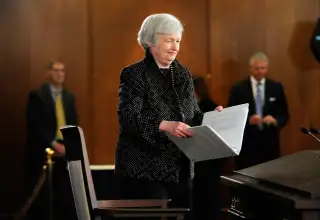4 Takeaways from the Fed's Big Meeting

This afternoon, the Federal Reserve released minutes from its mid-June meeting, providing a slightly more detailed picture of what chair Janet Yellen and her colleagues are thinking about the future of interest rates and monetary policy.
The June meeting itself had been a big shrug: The economy was getting better but not quickly enough to justify raising short-term interest rates; the Fed also said it would continue slowly tapering "quantitative easing," the massive program of bond buying that's meant to ease credit and stoke economic growth.
But here are three new things we've learned from the minutes.
1) Look for "quantitative easing" to end in October
We already kind of knew this, since the Fed has been reducing its purchases as a steady rate, but the minutes fill in a detail:
Some committee members had been asked by members of the public whether, if tapering in the pace of purchases continues as expected, the final reduction would come in a single $15 billion per month reduction or in a $10 billion reduction followed by a $5 billion reduction. Most participants viewed this as a technical issue with no substantive macroeconomic consequences…
But:
… participants generally agreed ... it would be appropriate to complete asset purchases with a $15 billion reduction in the pace of purchases in order to avoid having the small, remaining level of purchases receive undue focus among investors. If the economy progresses about as the Committee expects, warranting reductions in the pace of purchases at each upcoming meeting, this final reduction would occur following the October meeting.
Bear in mind that this just means the Fed will stop buying bonds. It will still own over $4 trillion worth of them.
2) The Fed is divided about how to read inflation data
In a press conference after the meeting, Yellen said that although inflation seemed to be picking up a bit, the numbers were too "noisy" to conclude that inflation would go above the Fed's 2% target for long.
The minutes of the meeting suggest that the other Fed governors and regional Fed presidents are divided on this. Some are worried that inflation is still far too low, indicating an economy that's still too slack. And it looks like the recent strong jobs numbers, released after the meeting, which brought unemployment down to 6.1%, won't change the minds of the inflation doves.
Some participants expressed concern about the persistence of below-trend inflation, and a couple of them suggested that the Committee may need to allow the unemployment rate to move below its longer-run normal level for a time in order keep inflation expectations anchored and return inflation to its 2 percent target, though one participant emphasized the risks of doing so.
But there's still a vocal hawk team. Although price increases are very low, their main concern is that the Fed won't be able to react fast enough when the economy turns.
… other participants expressed concern that economic growth over the medium run might be faster than currently expected or that the rate of growth of potential output might be lower than currently expected, calling for a more rapid move to begin raising the federal funds rate in order to avoid significantly overshooting the Committee's unemployment and inflation objectives.
3) The Fed is worried that it's being taken for granted.
...participants also discussed whether some recent trends in financial markets might suggest that investors were not appropriately taking account of risks in their investment decisions… [and] not factoring in sufficient uncertainty about the path of the economy and monetary policy.
What's the problem with that? There's always concern that easy policy will stoke an asset bubble. But Yellen has said that while she's keeping this on her radar, it's not a major concern yet. One good reason to think so: The housing market, the source of the really dangerous bubbles, is hardly frothy.
Despite attractive mortgage rates, housing demand was seen as being damped by such factors as restrictive credit conditions, particularly for households with low credit scores; high down payments; or low demand among younger homebuyers, due in part to the burden of student loan debt.
4) The labor market still looks weaker than it should be.
Although unemployment is down, some participants in the Fed meeting feel that many workers are still struggling to find work—they note that many workers have dropped out of the labor force altogether—and those with jobs still aren't in a strong position to demand higher wages.